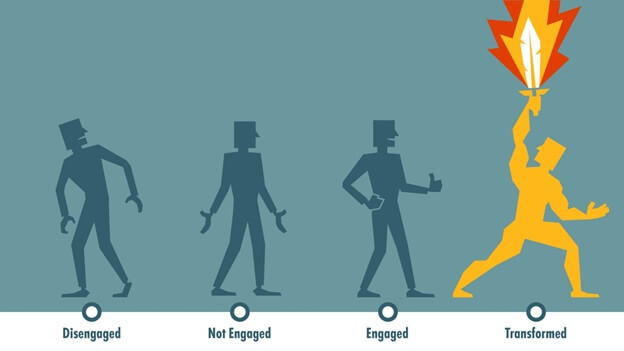
We all can agree that security training is critical, but have you ever wondered why your organization does not share your same level of excitement when it comes training time? The majority of organizations struggle with getting employees motivated and enthusiastic about training. Many employees look at training as a quarterly or yearly checkbox with the goal being to click through slides as quickly as possible or try and bear another 30-minute corporate video. So what do you do? How do you move your organization from viewing training as a required drudgery to something memorable and exciting? The secret is engagement. In this post, we are going to discuss the secret sauce of leveling up your training program by understanding and focusing on the four stages of engagement and transforming your employees into Defenders of security.

The Four Stages of Engagement
Disengaged There is a natural tendency for employee disengagement when it comes to training. Years of disengaging training creates disengaged employees. A person can sit through only so many dull PowerPoints or read verbatim compliance standards so many times before disengagement sets in. A disengaged employee is the employee who skips through the training slides as quickly as possible to try and pass the test or lets the presentation play in the background so they can meet the required training. This person has a negative perception towards training and can undermine success for the rest of the organization. Not Engaged Someone who is not engaged may understand that training is a requirement of their role and will participate in the training to the minimum they must. However, they would be just as happy without it. Engaged Engaged employees are employees that are enthusiastic about training and see the value it provides. They support training initiatives and see the positive impacts it has on an organization. Transformed A transformed individual is not only engaged in training but works to transform the level of engagement for others as well. A transformed employee is the person you want to have by your side to build excitement and support for your training initiatives and to be your first Defenders.
The goal is Transformation
“Transformed people transform people” – Richard Rohr
Transformed employees should be a north star goal for any organization. Transformed employees become extensions of your security or training team. They are the front-line Defenders and training advocates for your organization. Each employee that reaches the transformed level of engagement is another voice for the value of training and a sounding board on how it can be improved.
Four questions to determine your stage

Following the Kirkpatrick Model of “Evaluating Training Programs,” the following three questions can help you get a measure of your organization’s current stage.
- Reaction: Do your employees look forward to and enjoy your organization’s training?
- Learning: Do your employees feel they have the training they need to be successful in their role?
- Behavior: Have your employees had changes in behavior, performance, or activity post-training?
- Results: Do your organizational measurements such as security incidents, compliance violations, and so forth show improved performance?
Now that you know the four stages of engagements and four questions to determine your stage, you are ready to take your first step of accessing where your organization currently is. In our next post, we will dive deeper into how to transform your employees and what this looks like from the employee, leader, and executive perspective.

